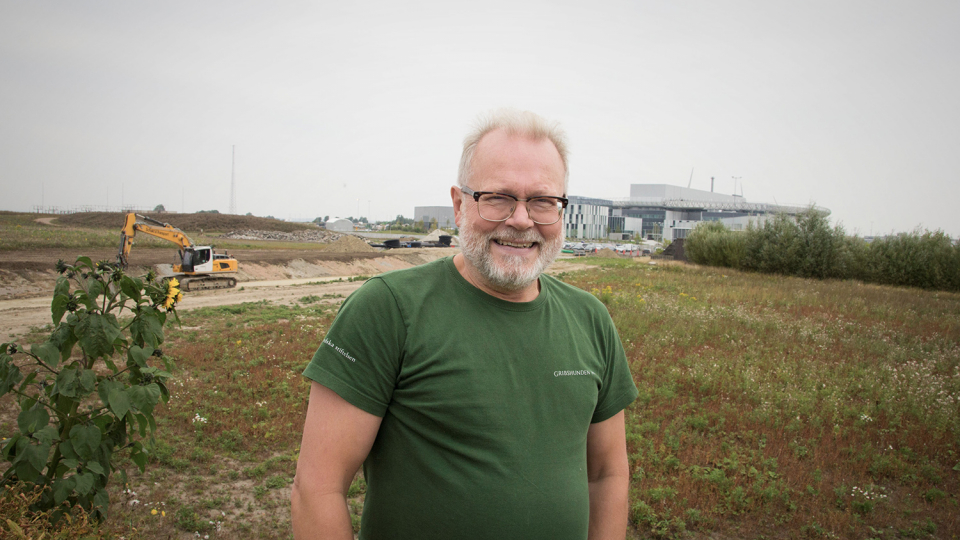Originally published on the Faculty of Science’s news site.
It is a catalyst that will modernise the Faculty of Science, both at Brunnshög and Sölvegatan. Dean Sven Lidin may have become “nearsighted, flabby and middle-aged” during his ten years in symbiosis with Science Village, but his future visions are more vital than ever.
It is one of those pale September mornings when there is one online meeting after another. But a few minutes after 11:00, the dean of the Faculty of Science, Sven Lidin, emerges from his office with his glasses on the tip of his nose and sits down in one the armchairs in the corridor. He is exhilarated, as we are going to talk about Science Village – the 18-hectare research hub that is to be built at Brunnshög between ESS and MAX IV. What Lidin doesn’t know about the project is not worth knowing. Ever since 2010, when he was recruited to Lund, he has worked in different roles on the establishment process. This work intensified when he became dean in 2017 and the chair of the University’s Science Village Group. Even though it will take 20-30 years before the eldorado for science is fully built, the basic idea is in place: Science Village is to be an attractive and high-tech node for research, education and innovation directly adjacent to ESS and MAX IV.
He sees the establishment of activities at Brunnshög as the grand finale of the University’s “snail-like” journey eastwards – a journey that began 60 years ago with what is now the Faculty of Engineering (LTH). The Faculty of Science was involved at an early stage when the plans for Science Village began to crystallise. And that certainly remains the case today. For the faculty, the first stage of the plan, which will be completed around 2025-2026, entails the transfer of NanoLab. The plans for stage two include setting up parts of the physics and chemistry departments at Brunnshög. The activities that will be involved after that point and the details of the funding model are yet to be determined. However, over the past year there have been major steps forward. Now, significantly more faculty employees are positive about getting on board the visionary-oriented Science Village train.
“It has been a long and exciting journey on which I have been able to work with many skilled exponents of change. We have a clear assignment from the government to ensure that all aspects of Sweden as a knowledge nation are represented at Brunnshög. We are to do that at the same as we must shape the activities based on our resources. Nothing is gained by overstretching”, he says.
Sven Lidin considers what is most important from a faculty perspective is to plan and set up activities in a responsible and sustainable way. Involving the organisational units is vital. Lidin emphasises how important it is that the departments that are not initially part of the move to Brunnshög see the opportunities that open up at Sölvegatan, rather than be concerned about sinkholes appearing in the Knowledge Highway.
In the summer, the Faculty of Science and LTH opened a joint project office focusing on overseeing campus development in Science Village. The office, headed by Eva Åkesson, previously deputy vice-chancellor of Lund University and former vice-chancellor of Uppsala University, will, according to Lidin, play an important role in the faculties’ and University’s establishment of activities at Brunnshög.
“The office provides a physical focal point. Purely in organisational terms, it is essential. We have spent many years planning what we want to do in Science Village. But progress needs coordination of the practical and intellectual construction project”, says Sven Lidin.
He looks forward to continuing to be a driving force in the faculty’s and University’s journey towards the north-east. Even though the work on establishing support has not always been a cushy job and Lidin during his ten years with Science Village has become “nearsighted, flabby and middle-aged”, he is filled with confidence, belief in the future and optimism about developments over the next few years and decades.
“I have learned a lot about how processes for establishing support and decision-making go hand in hand. And also that I work in an organisation that is full of wise heads”, says Sven Lidin.
It is time to drive to Science Village to take photographs. We park at MAX IV and walk out onto the overgrown pasture land that is soon to be developed. Finds from archaeological excavations show that humans were active here as far back as 5 800 years ago. Hopefully, Science Village will add to the continuing long chain of human activity at Brunnshög over the coming centuries. We get to the top of an embankment and look out over the tramway, windmill and the silver-coloured research facilities that tower like high-tech spaceships over the flat agrarian landscape.
What would you see here at Brunnshög in 2030?
“Paradise on earth. Ha, joking aside, we will see an extremely exciting city district in which the University and the major facilities constitute an important part. Quite simply a very attractive and modern knowledge and living environment.”
And looking even further ahead?
“From a glaciological perspective, ever since the University was founded it has moved snail-like towards the north-east. If the new hospital is built at Brunnshög, which is one of the alternatives, perhaps the snail will get a bike. But by 2050 I am sure that we will see the major part of the Faculty of Science’s activities brought together at Brunnshög.”
Text and photo: Johan Joelsson, press officer at the Faculty of Science

